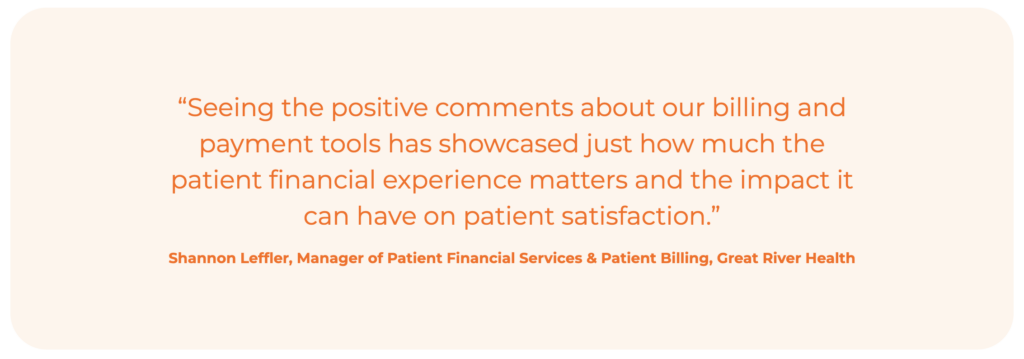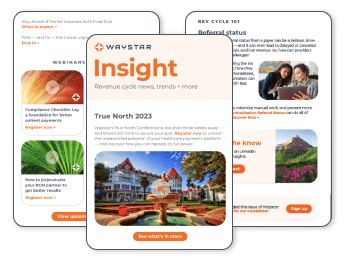Imagine a physician asking a patient to decipher a complex medical diagnosis and develop their own treatment plan. It sounds absurd, doesn’t it?
Yet patients are often expected to decode multi-page, jargon-filled bills — and somehow “pay upon receipt.”
But what if unpacking the psychology behind patient payment obstacles could help organizations achieve better outcomes — for both satisfaction and collections?
Why patients don’t pay: It’s not just about the cost
As patients take on more financial responsibility through higher premiums and deductibles, the burden is growing.
Nearly three in four adults are worried about being able to afford healthcare. That makes step one for providers clear: You must offer realistic, accessible payment options. Financial assistance, payment plans, digital-first billing — no effort is too small when the majority of Americans are concerned about affording care.

That said, while cost is a major factor, it’s not the only one. The why behind what’s owed — and how it’s communicated — plays a powerful role.
Behavioral science helps us understand the emotional and cognitive drivers behind payment decisions. Our feelings, habits, and biases often outweigh logic, exacerbating psychological hurdles patients face, such as:
- Fear of high costs
- Lack of transparency
- Decision fatigue
To untangle the complexities and overcome them, let’s further explore each of these obstacles.
Why patients don’t pay
1. Fear of high costs
Money is one of the most common stressors in daily life. According to the American Psychological Association, 63% of people put financial stress at the top of the list. Drill down on healthcare costs and you’ll see an obvious trickle-down effect. A KFF research study finds that roughly:
- Half of adults say they’d be unable to pay an unexpected medical bill of $500 without going into debt, and
- Two in five adults (41%) are already in debt due to medical or dental bills.
When patients receive a bill they didn’t expect — especially one they can’t pay in full — it’s easier to avoid it altogether. Without self-service tools or flexible options, the bill simply gets set aside … sometimes indefinitely.
Why patients don’t pay
2. Lack of transparency
Unclear bills break trust. Patients don’t just get frustrated — they may avoid care altogether or choose a different provider in the future.
One Accenture study found that patients are twice as likely to switch providers after a negative front-desk or online experience than after a poor clinical one. But there’s a silver lining for healthcare organizations: 84% of patients say they’ll stay with a provider who offers easy payment processes.
Transparent billing and upfront cost estimates can go a long way toward retention — and timely payments.

Why patients don’t pay
3. Decision fatigue
The average adult makes 35,000 decisions a day. Add a confusing bill full of codes and line items? Patients may delay payment simply because they don’t have the mental energy to deal with it at that moment.
But this is a solvable problem — and a missed opportunity from the provider perspective. The more decisions you can take out of the equation, the higher a patient’s likelihood to pay.
3 simple steps to optimize your patient payment processes
To put patient payment psychology to work in your organization:
- Audit your current payment communications and identify friction points. Where do patients stop engaging most often? Start there.
- Implement behavioral strategies. Personalize messaging, offer flexible payment options, and provide transparent cost estimates upfront.
- Continuously measure and refine. Track key metrics and adjust your approach based on patient feedback.
Waystar Patient Payments is designed with patient psychology in mind so healthcare organizations can provide a simpler billing experience, empowering patients with multiple ways to pay and, ultimately, increasing payments.
Healthcare organizations using Waystar see 60–80% self-service pay rates, with more than half of payments made via mobile devices.

Real-world impact: behavioral science in action
Behavioral payment strategies aren’t just theory. They’re working in real healthcare organizations today.
Health system speeds self-service payments + slashes call volume
Great River Health faced a major challenge. Their payments portal lacked functionality and frustrated both patients and staff. With no easy self-service payment plans, call volumes skyrocketed — reaching 6,000+ patient calls per month.
After partnering with Waystar, Great River launched a new, user-friendly payment portal that offers digital communications and self-enrollment for payment plans. Since switching to Waystar, Great River has seen a:
- 30% increase in self-service payments
- 50% drop in staff-assisted payments
- 60% decrease in monthly patient call volume
Additionally, Renown Health, a Northern Nevada-based health system, saw a 35% paper suppression rate, with bills paid digitally — before even printing.
The way to offer true patient financial care

If you’re ready to simplify patient payments for your organization, explore the full suite of Waystar Patient Payments solutions and see how they can transform your financial experience — for both patients and staff.



